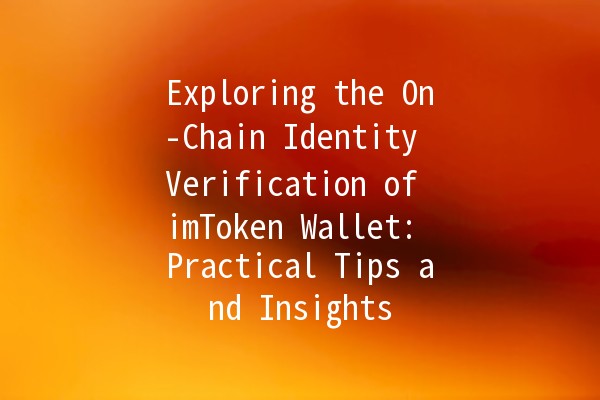In recent years, the rise of decentralized finance (DeFi) and blockchain technology has dramatically changed the landscape of digital transactions. Among the prominent players in this field is imToken, a digital asset wallet known for its robust security features and userfriendly interface. However, as the number of users increases, so does the need for effective identity verification to ensure transaction reliability and safety. In this article, we will delve into the aspects of onchain identity verification in imToken wallet, providing practical tips and strategies to enhance user experience and security.
Onchain identity verification refers to the process of confirming a user's identity using blockchain technology. This method ensures that all transactions and interactions are recorded on a public ledger, offering transparency and traceability. The significance of this technology cannot be overstated, particularly in a world where cybersecurity threats and fraud are on the rise.

Description: Smart contracts are selfexecuting contracts where the terms are directly written into code. They facilitate, verify, and enforce the negotiation or performance of a contract.
Application Example: Implementing smart contracts in imToken can automate the verification process. For instance, when a user wants to perform a transaction, the smart contract checks whether the user's credentials meet the set criteria. If they do, the transaction proceeds automatically, reducing the need for manual intervention.
Description: Multifactor authentication adds an additional layer of security by requiring two or more verification factors.
Application Example: imToken can enhance account security by requiring users to confirm their identity through a combination of something they know (like a password), something they have (like a mobile device), and something they are (like biometric verification). This makes unauthorized access exceedingly difficult.
Description: DIDs are a new type of identifier designed for verifiable, "selfsovereign" digital identities. They allow individuals to create and manage their own identity on the blockchain.
Application Example: By integrating DIDs into imToken, users can maintain control over their personal data. When verifying identity, the wallet can check the user's DID against the blockchain without needing to store sensitive information, thus enhancing privacy and security.
Description: Continuous monitoring involves regularly checking transactions and user activities for unusual patterns that may indicate identity fraud.
Application Example: imToken can employ algorithms to analyze transaction histories. If a user suddenly makes heavier transactions or logs in from an unrecognized device, the system will automatically flag these activities for further verification.
Description: User education is crucial for maintaining security. Users must understand the significance of identity verification and how to protect their accounts.
Application Example: imToken can host webinars or create informational resources that teach users about the importance of secure passwords, recognizing phishing attempts, and utilizing the wallet’s security features effectively. Wellinformed users can significantly reduce the risk of identity theft.
The implementation of effective onchain identity verification in imToken wallet is paramount for enhancing security, trust, and user experience. By leveraging innovative technologies such as smart contracts, multifactor authentication, and decentralized identifiers, imToken can create a secure environment for transactions. Continuous monitoring and user education are also key components in safeguarding identities and ensuring safe operations within the wallet. As digital asset transactions continue to grow, ensuring robust identity verification will play a pivotal role in the future of digital finance.
Onchain identity verification is the process of verifying a user's identity using blockchain technology, where all transactions are recorded on a public ledger. This ensures security and transparency, helping users authenticate their identities effortlessly.
Identity verification is essential in digital wallets to prevent fraud, enhance user trust, and comply with regulatory standards. It protects sensitive information and ensures that transactions are conducted by legitimate users only.
Smart contracts facilitate automated identity verification by executing predetermined rules without human intervention. When a user initiates a transaction, the smart contract checks their credentials against the criteria set within the contract, ensuring timely and secure processing.
Multifactor authentication adds extra layers of security by requiring users to provide multiple forms of identification before gaining access to their wallets. This greatly reduces the likelihood of unauthorized access, enhancing overall account safety.
Users can protect their identities through best practices such as creating strong passwords, enabling multifactor authentication, being aware of phishing scams, and regularly monitoring their transaction activity for unusual behavior.
Decentralized identifiers (DIDs) are unique identifiers stored on the blockchain that enable individuals to create and manage their identities without relying on a central authority. They enhance privacy and control, making them a significant addition to identity verification processes.
By integrating these strategies, imToken wallet can not only improve the security of user identities but also transform how users perceive and interact with digital wallets.